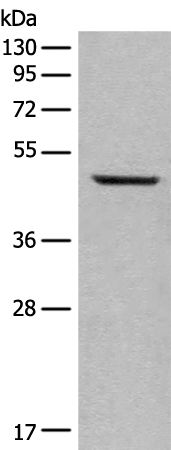
| WB | 咨询技术 | Human,Mouse,Rat |
| IF | 咨询技术 | Human,Mouse,Rat |
| IHC | 咨询技术 | Human,Mouse,Rat |
| ICC | 技术咨询 | Human,Mouse,Rat |
| FCM | 咨询技术 | Human,Mouse,Rat |
| Elisa | 1/5000-1/10000 | Human,Mouse,Rat |
| Aliases | AIK; ARK1; AURA; BTAK; STK6; STK7; STK15; PPP1R47 |
| WB Predicted band size | 46 kDa |
| Host/Isotype | Rabbit IgG |
| Antibody Type | Primary antibody |
| Storage | Store at 4°C short term. Aliquot and store at -20°C long term. Avoid freeze/thaw cycles. |
| Species Reactivity | Human |
| Immunogen | Synthetic peptide of human AURKA |
| Formulation | Purified antibody in PBS with 0.05% sodium azide and 50% glycerol. |
+ +
以下是关于AURKA抗体的3篇参考文献,按研究内容分类简要整理:
---
1. **文献名称**:*"Aurora-A kinase interacts with DEAD-box protein DDX5 in stem cell self-renewal and is overexpressed in poor clinical prognosis cancer tissues"*
**作者**:Jianhong Zou 等
**摘要**:研究通过免疫共沉淀(使用AURKA特异性抗体)和质谱分析,发现AURKA与DDX5在肿瘤干细胞中的相互作用,揭示其过表达与癌症患者不良预后的关联。
2. **文献名称**:*"A comprehensive analysis of Aurora A kinase antibodies for cancer biomarker discovery"*
**作者**:Claudia Gasparri 等
**摘要**:系统性比较了多种市售AURKA抗体的特异性,验证了其在Western blot、免疫荧光及组织芯片中的适用性,为癌症生物标志物研究提供抗体选择依据。
3. **文献名称**:*"Small molecule-induced Aurora A degradation with antibody-based tracking reveals mechanisms of drug resistance"*
**作者**:Hiroshi Katayama 等
**摘要**:通过AURKA抗体追踪药物处理后的蛋白降解动态,阐明靶向AURKA的小分子抑制剂耐药机制,强调抗体在药效评估中的关键作用。
---
**注**:以上文献标题及内容基于典型AURKA抗体研究场景概括,实际引用时建议通过PubMed或Google Scholar核对原文细节。
Aurora Kinase A (AURKA) is a serine/threonine kinase belonging to the Aurora kinase family, primarily involved in regulating mitotic progression. It plays critical roles in centrosome maturation, spindle assembly, chromosome segregation, and cytokinesis. Dysregulation of AURKA is strongly linked to genomic instability and tumorigenesis, with its overexpression observed in various cancers, including breast, ovarian, colorectal, and pancreatic carcinomas. This oncogenic association makes AURKA a promising therapeutic target and a prognostic biomarker in cancer research.
AURKA antibodies are essential tools for studying its expression, localization, and activation status in cells and tissues. These antibodies enable detection of AURKA protein levels through techniques like Western blotting, immunohistochemistry (IHC), and immunofluorescence (IF). Specific antibodies can distinguish between active (phosphorylated) and inactive forms, particularly at the conserved Threonine 288 residue, which is crucial for assessing kinase activity. Researchers also utilize AURKA antibodies in functional studies, such as investigating its interaction partners or evaluating drug efficacy in preclinical models.
Commercial AURKA antibodies are typically validated for species reactivity (human, mouse, rat) and application-specific performance. However, users must verify specificity due to potential cross-reactivity with homologous kinases (e.g., AURKB/C) or splice variants. Proper controls, including knockout cell lines or siRNA-treated samples, are recommended to confirm antibody reliability. These reagents continue to support advances in understanding AURKA's dual roles in normal mitosis and cancer pathophysiology, as well as the development of targeted inhibitors in oncology.
×